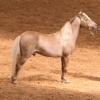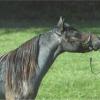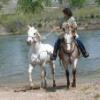Q on few spots
Forums
Thanks Acc , maybe Ill look
Thanks Acc , maybe Ill look for a leopard or blanket instead lol
Your percentage will be lower
Your percentage will be lower but your choice range would be wider. Tough call. LOL
A fewspot is a horse that has
A fewspot is a horse that has two copies of Lp AND a large nose-to-toes pattern gene. A fewspot can throw anything from another fewspot to a characteristics-only, depending on what other "pattern" genes (i.e., large blanket, small blanket, lacy blanket, varnish, etc.) may be part of the fewspot's genetic recipe.
"Roaning out" is PART of Lp's function, some just seem to roan out and leave varnish marks faster than others. You breed for Lp, you breed for "roaning out", and try to come up with the lines/colours that most inhibit roaning.
That said, the only "true" varnish roan we have is the chestnut gelding, who also has a blanket. Misty's pattern is still in the "what the heck" category--too big to be a snowcap, too small to be a fewspot, sired by a roaned out blanket, her 'black varnish marks' pretty much have stayed the same since she was born (according to people who have known her/her breeder). And she's bay, to boot, so there's no explaining, at this point, her black 'varnish marks'....LOL
Diane
Oh, and on your first
Oh, and on your first questions--a HZ varnish roan is a theorized critter at the moment, is believed to have amber hooves, and not much discernible pattern--starts out as 'frosting' and then sort of morphs into a roany-white-ish thingy going on with the top of the rump/back, and sort of sliding downwards and forwards. It would look nothing like a fewspot.
Diane
well thats good that I would
well thats good that I would be able to tell the difference between an HZ varnish roan and a few spot , I was worried that Id buy a mare snd have no chance of spots
I understand that a few spot could produce a few spot if bred to another horse with Lp but are saying that it could produce also a few spot when bred to a solid ?
A fewspot could only produce
A fewspot could only produce another fewspot when bred to a horse carrying LP. Most LP carriers are not hidden, they show at least characteristics.
The problem I see is that I
The problem I see is that I have now seen at least three Mini so-called Fewspots that are greyed out Leopards!
rabbitsfizz wrote:The problem
[quote=rabbitsfizz]The problem I see is that I have now seen at least three Mini so-called Fewspots that are greyed out Leopards![/quote]Then they ARENT fewspots. Just like grays aren't max whites, and black silvers and chocolate palominos.
There is no problem there.
Ayup--hardest part in
Ayup--hardest part in locating a true few spot is dealing with people who THINK they have a few spot, i.e., a chestnut with a few spots on it...or as Rabbit said, greyed out leopard.
On the characteristics-only thing, a lot depends on what you consider "eligible areas" for them to be found, especially when dealing with a black-based horse. Ms Pearl only started showing proper/noticeable striped feet last summer. She's in her late teens now. Her mottled skin is where the sun don't shine, literally--you need to get a lot more intimate with her than I'd consider doing. And her sclera is all but invisible, you have to catch her at just the right angle to see it.
So, under that sort of circumstances, Ms Pearl, bred to a few spot, as a 25% chance of producing another few spot. I wouldn't be holding my breath as that would need the same luck I would need to win lotto. LOL
Diane
dont worry if I find anything
dont worry if I find anything I will be posting pics on here to confirm the pattern before I hand over any money lol !!!!
The problem is that they are
The problem is that they are being represented as Fewspots (obviously!)
Visually it is almost impossible to tell.
Also add Roaned out to that- that is even harder to tell, and impossible to prove if both parents are Appy!
I know of at least one Roaned out stallion, sold as a Fewspot (genetically possible in his case, two Appy parents) who was not, and threw a very disappointing shedload of Roan foals for his new owner.
that would be very
that would be very dissapointing
That's where asking to see
That's where asking to see foal photos comes in handy--a true few spot is born that way.
Diane
now that is helpful , am I
now that is helpful , am I right in thinking a snowcap/fewcap is homozygous for blankets and a few spot is homozygous for two patterns one of which has to be leopard , sorry if its a dumb question but I dont completely understand the appys
No, a fewspot is homozygous
No, a fewspot is homozygous for LP. It may have only one copy of PATN1 (the leopard gene). The blanket patterns are more complicated. There isn't thought to be one gene responsible for blankets; more likely many pattern-helping genes which determine the size of the blanket. A snowcap is also homozygous for LP and has one or more pattern genes (but not PATN1).
ah so it could produce 50% of
ah so it could produce 50% of foals as characteristics only :-(
supaspot60 wrote:ah so it
[quote=supaspot60]ah so it could produce 50% of foals as characteristics only :-([/quote]
That can happen, if you're [i]really[/i] unlucky, and you're using non-LP mares. Of course, the color percentage will be much higher with colored mares.
My fewspot stallion is [i]not[/i] homozygous for PATN1, but he seems to have enough pattern helping genes to throw a high percentage of color. His foals, at a minimum, have a small white blanket over their hips. Not what I'm hoping for, but better than nothing!
It also helps if you use
It also helps if you use mares from a well marked appy sire and/or dam even if they don't carry LP. These mares are more likely to carry a hidden pattern gene that they can pass on to the foal.
would you describe this
would you describe this pattern as snowflake ? someone suggested it was varnish but shes 12 years old and it has changed very little in the five years that Ive had her , is the silver mane part of the appy or something separate
admin wrote:It also helps if
[quote=admin]It also helps if you use mares from a well marked appy sire and/or dam even if they don't carry LP. These mares are more likely to carry a hidden pattern gene that they can pass on to the foal.[/quote]
I have a silver bay mare by a red leopard sire , she has no characteristics at all that I can see , so youre saying that its poosible that she could be hiding a pattern but have no LP gene to express it ??? :-) woohoo, thats brilliant
Quote:I have a silver bay
[quote]I have a silver bay mare by a red leopard sire , she has no characteristics at all that I can see , so youre saying that its poosible that she could be hiding a pattern but have no LP gene to express it ??? woohoo, thats brilliant[/quote]
Yes if her sire was heterozygous for PATN1 then she would have a 50% chance of carrying the pattern gene. If he carried other pattern genes instead of/in addition to PATN1 it gets a bit more complicated.
Snowflake and Varnish are
Snowflake and Varnish are genetically the same thing, but different expressions of it. Those with suppression alleles and/or black bases are more likely to get snowflakes when varnishing out.
As for horses with hidden pattern alleles, Reminic In Spots is a horse from 2 QH parents. He was born with a spotted blanket. His dam was a varnish roan that didn't start showing until she was around 8 and his sire carried a PATN2 allele. Get LP and that PATN2 together and BAM spotted blanket baby. His full sister inherited the mother's LP but not the father's PATN2 and is characteristics only. She was the proof that the father only had 1 PATN allele to pass on.
http://www.reining-appaloosa.com/Remini…
You can think of LP as the 'switch' that turns on PATN. Without it a PATN horse looks like any other. Yay polygenic colors!
To make it easier to know
To make it easier to know true fewspots, hold off buying for a couple months... the Appaloosa Project has located the Lp gene and there will soon be a test for it! :)








No I believe a horse can be
No I believe a horse can be LP/LP and not have a spotted pattern (aka it would just be roaned out). Also a fewspot does not guarantee spots (unless it is homozygous for a pattern as well), only characteristics.